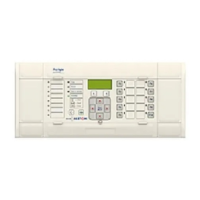P74x/EN FD/N
1, P742, P743
(FD) 9-
2.12 Ethernet and redundant Ethernet boards
The optional Ethernet board (ZN0049) has 3 variants which support the IEC 61850
implementation:
• 100 Mbits/s Fiber Optic + 10/100 Mbits/s Copper for P741 and P743
• 100 Mbits/s Fiber Optic + 10/100 Mbits/s Copper + modulated IRIG-B for P741 only
• 100 Mbits/s Fiber Optic + 10/100 Mbits/s Copper + demodulated IRIG-B for P741 only
The optional Redundant Ethernet board (ZN0071) has 6 variants (refer to Px4x/EN REB user
guide):
• redundant Ethernet (SHR protocol) with modulated or un-modulated IRIG-B,
• redundant Ethernet (RSTP protocol) with modulated or un-modulated IRIG-B,
• redundant Ethernet (DHS protocol) with modulated or un-modulated IRIG-B.
This card is fitted into Slot A of the relay, which is the optional communications slot. Each
Ethernet card has a unique MAC address used for Ethernet communications. This is printed
on the rear of the card, alongside the Ethernet sockets.
The 100 Mbits/s Fiber Optic ports use ST
®
type connectors and are suitable for 1300nm
multi-mode fiber type.
Copper ports use RJ45 type connectors. When using copper Ethernet, it is important to use
Shielded Twisted Pair (STP) or Foil Twisted Pair (FTP) cables, to shield the IEC 61850
communications against electromagnetic interference. The RJ45 connector at each end of
the cable must be shielded, and the cable shield must be connected to this RJ45 connector
shield, so that the shield is grounded to the relay case. Both the cable and the RJ45
connector at each end of the cable must be Category 5 minimum, as specified by the IEC
61850 standard. It is recommended that each copper Ethernet cable is limited to a maximum
length of 3 meters and confined within one bay/cubicle.
When using IEC 61850 communications through the Ethernet card, the rear EIA(RS)485 and
front EIA(RS)232 ports are also available for simultaneous use, both using the Courier
protocol.
2.13 Mechanical layout
The case materials of the relay are constructed from pre-finished steel that has a conductive
covering of aluminium and zinc. This provides good earthing at all joints giving a low
impedance path to earth that is essential for performance in the presence of external noise.
The boards and modules use a multi-point earthing strategy to improve the immunity to
external noise and minimize the effect of circuit noise. Ground planes are used on boards to
reduce impedance paths and spring clips are used to ground the module metalwork.
Heavy duty terminal blocks are used at the rear of the relay for the current and voltage signal
connections. Medium duty terminal blocks are used for the digital logic input signals, the
output relay contacts, the power supply and the rear communication port. A BNC connector
is used for the optional IRIG-B signal. 9-pin and 25-pin female D-connectors are used at the
front of the relay for data communication.
Inside the relay the PCBs plug into the connector blocks at the rear, and can be removed
from the front of the relay only. The connector blocks to the relay’s CT inputs are provided
with internal shorting links inside the relay which will automatically short the current
transformer circuits before they are broken when the board is removed.
The front panel consists of a membrane keypad with tactile dome keys, an LCD and 12
LEDs mounted on an aluminium backing plate.

